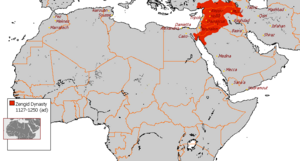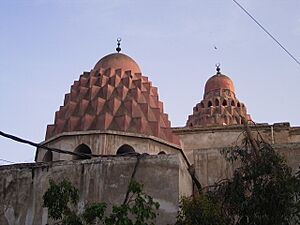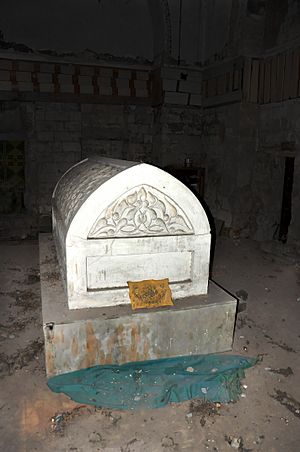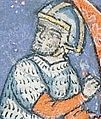Nur ad-Din (died 1174) facts for kids
Quick facts for kids Nur ad-Din |
|||||
|---|---|---|---|---|---|
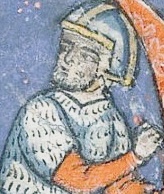 |
|||||
| Emir of Aleppo | |||||
| Reign | 1146 – 15 May 1174 | ||||
| Predecessor | Imad ad-Din Zengi | ||||
| Successor | As-Salih Ismail al-Malik | ||||
| Emir of Damascus | |||||
| Reign | 1154 – 15 May 1174 | ||||
| Predecessor | Mujir ad-Din Abaq | ||||
| Successor | As-Salih Ismail al-Malik | ||||
| Born | 1118 | ||||
| Died | 15 May 1174 (aged 56) Damascus, Seljuk Empire |
||||
| Burial | Nur al-Din Madrasa, Damascus, Syria | ||||
| Spouse | Ismat ad-Din Khatun | ||||
| Issue | As-Salih Ismail al-Malik | ||||
|
|||||
| Dynasty | Zengid dynasty | ||||
| Father | Imad ad-Din Zengi | ||||
| Religion | Sunni Islam | ||||
Nur ad-Din Mahmud Zengi (نور الدين محمود زنگي; born February 1118 – died 15 May 1174) was a powerful Muslim ruler. His name, Nur ad-Din, means "Light of the Faith" in Arabic. He was part of the Zengid family, who ruled the region of Syria.
Nur ad-Din ruled from 1146 to 1174. He played a very important role during the time of the Second Crusade. He worked to unite Muslim lands against the Crusader states.
Contents
Fighting the Crusaders
Nur ad-Din was the second son of Imad al-Din Zengi. His father was a strong leader and an enemy of the Crusaders in Syria. After his father was killed in 1146, Nur ad-Din and his older brother, Saif ad-Din Ghazi I, split their father's lands.
Nur ad-Din took control of Aleppo, while his brother ruled Mosul. Soon after becoming ruler, Nur ad-Din attacked the Principality of Antioch. He captured several castles in northern Syria. He also stopped Joscelin II from taking back County of Edessa. This city had been captured by Nur ad-Din's father in 1144.
In 1146, after a Crusader attempt to retake Edessa, Nur ad-Din punished the city's people. He destroyed its defenses because they had helped Joscelin.
Forming Alliances
Nur ad-Din wanted to unite Muslim leaders in northern Iraq and Syria. This would create a stronger front against the Crusaders. In 1147, he made a treaty with Mu'in ad-Din Unur, the governor of Damascus. As part of this agreement, Nur ad-Din married Mu'in ad-Din's daughter, Ismat ad-Din Khatun.
Together, they attacked the cities of Bosra and Salkhad. These cities were held by a rebellious leader. However, Mu'in ad-Din was always careful about Nur ad-Din's plans. He did not want to upset his Crusader allies in Jerusalem. To show he meant no harm, Nur ad-Din left Damascus. He then turned his attention to the Principality of Antioch. There, he captured several towns like Artah and Bara.
The Second Crusade Arrives
In 1148, the Second Crusade reached Syria. It was led by King Louis VII of France and King Conrad III of Germany. Nur ad-Din's earlier victories had made it very hard for the Crusaders to take back Edessa. The Crusaders decided to attack Damascus instead. This was because Damascus was allied with Nur ad-Din.
Mu'in ad-Din, the ruler of Damascus, reluctantly asked Nur ad-Din for help. The Crusader attack on Damascus failed quickly, lasting only four days.
Victories Against Antioch
Nur ad-Din used the Crusade's failure to plan another attack on Antioch. In 1149, he attacked areas near the castle of Harim. He then surrounded the castle of Inab. The Prince of Antioch, Raymond of Poitiers, quickly came to help.
Nur ad-Din's army completely defeated the Crusaders at the Battle of Inab. Prince Raymond was killed in this battle. His head was sent to Nur ad-Din, who then sent it to the Caliph in Baghdad. Nur ad-Din marched to the coast. He showed his power over Syria by symbolically bathing in the Mediterranean Sea.
He did not attack Antioch itself. Instead, he captured all the Antiochene land east of the Orontes. In 1150, he defeated Joscelin II for the last time. Joscelin was captured and died in prison in 1159. Nur ad-Din also tried to stop King Baldwin III of Jerusalem from moving Latin Christian people from Turbessel. In 1152, Nur ad-Din captured and burned Tortosa for a short time.
Uniting the Muslim Lands
Nur ad-Din dreamed of uniting all Muslim forces. He wanted to bring together lands between the Euphrates River and the Nile River. This would create a strong front against the Crusaders. In 1149, his brother Saif ad-Din Ghazi died. His younger brother, Qutb ad-Din Mawdud, took over Mosul.
Qutb ad-Din recognized Nur ad-Din as the main ruler of Mosul. This meant that the major cities of Mosul and Aleppo were now under one leader. Damascus was the only city left to unite all of Syria.
Taking Damascus
After the Second Crusade failed, Damascus had renewed its treaty with the Crusaders. After Mu'in ad-Din died in 1149, his successor, Mujir ad-Din Abaq, continued this policy. In 1150 and 1151, Nur ad-Din tried to capture Damascus. He was not successful, but he did get them to recognize his authority.
When the Crusaders captured Ascalon in 1153, Mujir ad-Din would not let Nur ad-Din's army pass through his land. Mujir ad-Din was a weaker ruler. He even agreed to pay the Crusaders money each year for their protection. Because Damascus was weak, Nur ad-Din was able to take over in 1154. The people of Damascus helped him.
Damascus became part of Nur ad-Din's territory. All of Syria was now united under his rule. He was careful not to attack Jerusalem right away. He even continued to send the yearly payment to the Crusaders.
Battles and Diplomacy
In 1157, Nur ad-Din surrounded the Knights Hospitaller at the Crusader fortress of Banias. He defeated a Crusader army from Jerusalem led by King Baldwin III. He also captured Bertrand de Blanquefort, a Grand Master of the Knights Templar. However, Nur ad-Din became ill that year. This gave the Crusaders a short break from his attacks.
In 1159, the Byzantine emperor Manuel I Comnenus arrived in Antioch. The Crusaders hoped he would attack Aleppo. But Nur ad-Din sent messengers and made an alliance with the emperor against the Seljuks. This disappointed the Crusaders. Nur ad-Din and his allies attacked the Seljuk sultan Kilij Arslan II from the east.
Later in 1160, Nur ad-Din captured the Prince of Antioch, Raynald of Châtillon. Raynald remained a prisoner for sixteen years. By 1162, Nur ad-Din went on a religious trip to Mecca. When he returned, he heard that King Baldwin III of Jerusalem had died. Out of respect for his strong opponent, he did not attack the Crusader kingdom.
The Challenge of Egypt
The Crusaders could not expand in Syria, so they looked south to Egypt. Egypt was weak because its rulers were very young. By 1163, the ruler was the young al-Adid, but the country was run by his chief minister, Shawar. That year, Shawar was overthrown.
The King of Jerusalem, Amalric I, then attacked Egypt. He said the Egyptians had not paid money they promised. This attack failed, but it made Nur ad-Din act. He attacked the Crusaders in Syria to distract them from Egypt. His attack on Tripoli failed.
Soon, the exiled Shawar asked Nur ad-Din for help. He wanted Nur ad-Din to send an army to put him back in power. Nur ad-Din's general, Shirkuh, convinced him to invade Egypt in 1164. The ruler of Egypt, Dirgham, allied with Amalric. But Amalric could not get his army ready in time. Dirgham was killed, and Shawar became chief minister again.
Shawar immediately forced Shirkuh out of Egypt. He then allied with Amalric. Amalric surrounded Shirkuh's army. Shirkuh agreed to leave Egypt when Amalric had to return home. This was because Nur ad-Din had attacked Antioch and surrounded the castle of Harenc. There, Nur ad-Din defeated the armies of Antioch and Tripoli. He did not attack Antioch itself, fearing a response from the Byzantines. Instead, he captured Banias and raided Crusader lands for two years.
In 1166, Shirkuh was sent to Egypt again. Amalric followed him in 1167. Amalric and Shawar made a formal agreement. The Crusaders took over Alexandria and Cairo. They made Egypt a state that paid them tribute. But Amalric could not hold Egypt while Nur ad-Din controlled Syria. He had to return to Jerusalem. In 1167, Nur ad-Din raided the County of Tripoli.
In 1168, Amalric tried to ally with Emperor Manuel and invaded Egypt again. Shawar's son, Khalil, and the Caliph al-Adid asked Nur ad-Din and Shirkuh for help. In early 1169, Shirkuh arrived. The Crusaders were forced to leave again. This time, Nur ad-Din gained full control of Egypt. Shawar was executed. Shirkuh became the chief minister of Egypt. Later, Shirkuh's nephew, Saladin, took over.
Death and Legacy
Nur ad-Din was busy in the north, fighting other groups. In 1170, he had to settle a disagreement between his nephews. After conquering Egypt, Nur ad-Din felt he had achieved his goal of uniting the Muslim states. He became very ill with a fever. He died at age 56 on 15 May 1174, in Damascus.
He was first buried there, then moved to the Nur al-Din Madrasa. His young son, As-Salih Ismail al-Malik, became his heir. Saladin declared himself a loyal follower. Saladin later took control of Syria and Egypt in 1185. He finally made Nur ad-Din's dream of a united Muslim state come true.
Nur ad-Din's Impact
Nur ad-Din was known as a strong leader. He was also seen as fair and wise. People said he was a very religious man. He believed that the Crusaders were foreigners who had come to take Muslim lands. However, he generally treated Christians living under his rule well.
During his time, many schools called madrasas were built in Syria. Nur ad-Din personally helped build half of them. These schools helped train religious scholars and leaders. Nur ad-Din also built hospitals (called bimaristans) and inns for travelers. He held court often so people could seek justice from him.
Nur ad-Din was a strong supporter of Sunni Islam. He changed two Shia mosques into Sunni schools. In November 1148, he stopped the Shia call to prayer in Aleppo. In the Muslim world, he is still remembered as a brave, religious, and humble leader. Historian Sir Steven Runciman said that Nur ad-Din loved justice above all else.
The chronicler Ibn al-Qalanisi wrote about Nur ad-Din in a very positive way. A modern group in the Syrian Civil War is named after Nur ad-Din.
Images for kids
See also
 In Spanish: Nur al-Din para niños
In Spanish: Nur al-Din para niños


